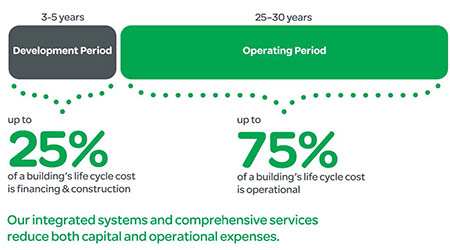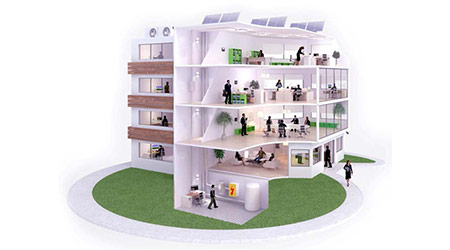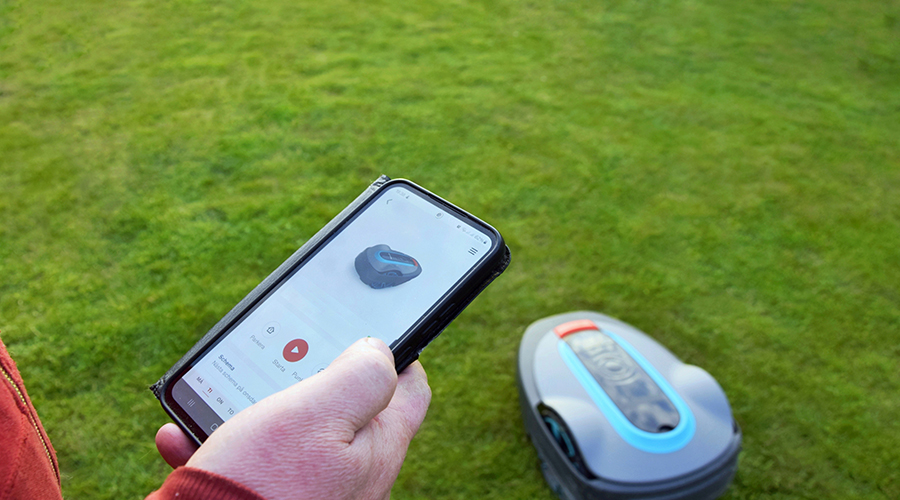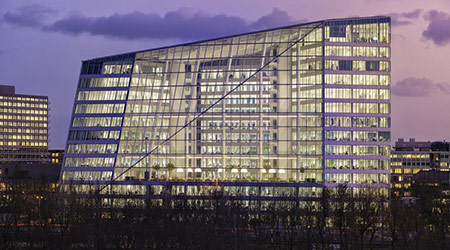SPONSORED
Schneider Electric - Branded Feature
Get Connected: Smart Buildings and the Internet of Things
As buildings become more connected, complex, and dynamic, there is a growing need for intelligent building technologies that provide data-driven insights to maximize operational efficiency, cut energy waste, and lower overall costs. This paper explores how smart buildings leverage the Internet of Things (IoT) to create new opportunities for information gathering and sharing, and the impact it has on buildings management and operations.
Evolution of Building Management
Over the years, buildings have become more complex and dynamic with multiple disparate systems and devices supporting a range of standards. Such complexity can lead to inefficiencies. When systems do not "talk" to one another, they operate in silos, and facility staff are unable to get a holistic view of building performance. This is one of the reasons why building energy management systems (BEMS) emerged to integrate a multitude of disparate systems and functions. However, while presenting a holistic view of operations helps organizations cut utility costs by making better strategic decisions around energy use, many of these early systems were not predictive. Instead these systems simply ran diagnostics and sent alerts after finding a problem.
The rate of change in building management technology over the past decade has been swift and diverse. That's good news for aging buildings and infrastructure. As depicted in the image below, up to 75 percent of a building's lifetime cost is spent on operations and maintenance, according to the U.S. Department of Energy and buildings are designed to last for decades. Consider, for instance, that more than half of all commercial buildings in operation in mature economies today were built before 1970, so it's important to consider technologies and scalable solutions that can optimize assets and limit operational costs over extended periods of time.

Keeping current with the latest building technology is difficult due to the large number of advances every year. To ensure success, building owners and operators unequivocally need to be aware of both the benefits and limitations of the newest technologies. Failure to do this may result in missed opportunities to reduce operational and energy costs and, improve occupant comfort and staff productivity.
The BEMS market is evolving along with the ecosystem of intelligent building technologies such as control systems and wireless technologies, according to Navigant Research. While energy management was the initial focus of BEMS, organizations now want these solutions to optimize sustainability, space utilization, operational efficiency, and employee productivity.
As a result, today's smart buildings are starting to leverage the Internet of Things (IoT) and building-information modeling (BIM) to connect various systems and devices to a centralized technology backbone. Through integration of real-time performance data and analysis to the BEMS, smart buildings help facility managers proactively identify problems before they occur to drive efficiency.
These new technologies are increasingly important as the power and efficiency demands of buildings evolve. Energy consumption around the world will increase by 56 percent by 2040, according to the U.S. Energy Information Administration. Our global population is expected to increase by 38 percent, from 6.9 billion in 2010 to 9.6 billion in 2050, and our electricity needs are projected to skyrocket in this "always on" digital economy. Buildings currently consume about 53 percent of the world's available electricity. By 2040, that consumption will increase to 80 percent of our electricity.
Consequently, organizations need a more analytical, data-driven approach to building operations and management to help maximize operational efficiency, cut energy waste, and lower overall cost. There is also an increasingly need for smart buildings that provide more comfortable, modern environments that enable people to work more effectively. In a study by the Continental Automated Buildings Association (CABA), buildings that include comfort and productivity measures (e.g., improved ventilation, enhanced lighting conditions, and green building certification measures that directly affect health and wellness, absenteeism, employee turnover, job performance and satisfaction) provide proven benefits beyond energy savings.
Buildings of all sizes can benefit from this more technological and analytical approach: research shows that the small and medium-size commercial building market is poised to grow by more than 60 percent – to $38 billion – by the year 2025. In fact, these small and medium-sized buildings can save 20 percent on their energy bills through more effective monitoring. Additionally, large commercial buildings using a collaborative IoT platform can improve building operations and cut energy use by 29 percent per year.
Smart Buildings and the IoT
What, exactly, is the IoT? And how does it relate to building energy management?
The IoT is the concept of connecting any device with an on/off switch to the Internet and/or to each other. IoT uses one common Internet Protocol (IP) to connect devices, which include everything from smartphones, tablets and digital assistants to various types of sensors and systems such as HVAC, lighting, and security.
In other words, the IoT is a fast-expanding digital ecosystem of connected devices.
In 2015, there were about 10 billion connected devices; by 2020, that number will more than triple to 34 billion. This growth is not surprising given the current environment where broadband Internet is widely available, technology costs are decreasing, smartphone use is becoming ubiquitous, and more and more devices are designed with built-in sensors and Wi-Fi capabilities.
So, how does the IoT enable smarter buildings?
The IoT helps create dynamic, and intelligent cloud-based interoperable networks by connecting electrical, mechanical, and electro-mechanical systems and platforms. By communicating with each other, these systems can help monitor themselves and act when necessary (e.g. turn down air-conditioning or heating needs in a little-used area) to provide the data and analytics needed for facility managers to intelligently optimize performance and create smarter buildings.
The technology to enable this competitive edge is already at hand. The Internet and significant price reductions on IT components such as wireless sensors have made smart building technologies much more affordable, creating a strong business case for owners and investors to invest in more intelligent technologies to increase building performance.
For example, advanced smart-energy sensors — a market whose revenue will almost triple between 2016 and 2025, from $1.2 million to $3.2 million, according to Navigant Research — can play a critical role in BEMS.
These devices contain "sensing" technology that captures and sends digital data to a BEMS to enable analysis and support actionable insight. Sensors that measure and provide continuous feedback on temperature, carbon dioxide level, humidity, and air pressure, for example, can deliver valuable information. Controllers, gateways, and sensors can also increase energy efficiency and help cut costs.

All at once, these devices, systems, and platforms connect to a central, open IP backbone to provide a holistic view of building performance. This backbone not only integrates all the data generated by the devices, but also presents it via a friendly user interface displays (desktop, tablet and mobile) that use powerful graphics, data-rich reports, and trend visualizations. Most importantly, this central backbone helps facility managers make strategic decisions through data analysis and actionable insights to ensure buildings are working smarter and running at maximum efficiency. Data analysis can also include artificial intelligence and machine learning algorithms that help buildings self-diagnose and optimize. In turn, this creates more comfortable environments that drive productivity by increasing employee engagement and satisfaction.
With the right IoT platform in place, buildings are ripe for improved energy management by easily integrating technology. An open, secure, and scalable platform that delivers deep and actionable insights can significantly increase operational efficiency within buildings. Additionally, correlation and analysis of data across historically disconnected systems can yield unexpected insights.
In short, IoT is creating enormous opportunities for information gathering and sharing that will have an astounding impact on the way buildings are managed and operated. By using a collaborative smart building IoT platform, devices are connected with software and services to realize these opportunities.
Real-World Example Highlights Future of Buildings
"The Edge" is a 40,000-ft. building in the Zuidas business district of Amsterdam. It exemplifies how a smart building can leverage the IoT to help improve all aspects of a company's workspace – from building management and energy to lighting and security.
Designed according to the "New World of Work" principles, the building challenges traditional corporate organizational structures. The Edge features a glass exterior, large open floor plans for flexible work spaces, and a dramatic 15-story atrium filled with natural light and surrounded by balconies.
As one of the most sustainable buildings in the world with a BREEAM-NL rating of 98.36 percent, the Edge features a broad range of integrated facility management and energy solutions: an electrical distribution system, IT infrastructure, control devices, and power-monitoring software. Sensors, valves, actuators, and other BEMS-compatible and connected field devices were installed in ceilings and in technical rooms to create a smarter building that makes the IoT a reality.
The building, constructed for the professional-services firm Deloitte, contains some 28,000 IoT sensors that monitor LED lights, temperature, humidity, infrared and motion, among many other internal building aspects. Sensors can alert cleaning staff of the day's most heavily used work areas, for example, and provide security information via an automated security robot that patrols the grounds at night.
These sensors and other systems also help employees as they go about their work day. Using a proprietary Deloitte app, employees can find a desk (there are no pre-assigned offices or cubicles), get access to car and bicycle parking and the company gym, adjust the heating in a workspace, and find colleagues, among other tasks.
In addition, the Edge is a net-zero energy building, producing 102 percent of its own energy via solar panels that line the building's roof and southern wall. Other eco-friendly features include aquifer thermal energy storage, motion sensor-activated ventilation, and rainwater harvesting.
All of the sensors and systems connect to a single IP backbone that gives real-time access to critical building data. The building leverages EcoStruxure Building (formerly SmartStruxure), an open, collaborative smart building IoT platform that connects BEMS with diverse building systems, devices and services to enable facility managers to proactively monitor, measure and control — both on-site and remotely — all the data from building and IT systems.
By linking devices, sensors, and systems, EcoStruxure Building helps manage building management, power supply and process functions to provide comprehensive building-system interconnectivity. This solution also leverages Microsoft's Azure cloud platform to improve the delivery of analytics, software, and global services.
The world of smart building technology is uniquely positioned to benefit from IoT. But, how can organizations – whether they're large multi-national entities or small to medium-sized businesses – best integrate IoT to deliver significant transformation over time?
Smart Building IoT Best Practices
The following smart building IoT best practices should be taken into consideration:
1. It's OK to test the use of IoT: Organizations that want to take more measured steps before revamping their building systems should start small. For instance, they could employ a pilot project that focuses on lighting or another aspect of building needs. Keep in mind that this and other systems need to have end-to-end configurability.
2. Build a solid plan from the beginning. What are the specific, measurable goals that your organization wants to accomplish? Careful planning from the start is key. Developing a thoughtful, solid plan will define the key requirements for hardware, software, security, and infrastructure, among other factors.
3. Include all key stakeholders. This plan should involve all facility's stakeholders, including but not limited to operations, finance, IT and security. The stakeholders should take time to establish operational, productivity and sustainability goals and objectives that align with the values and mission of the organization and evaluate ROI before broadening scope. Then, they can present a unified plan and collaborate with key contractors and vendors to produce a more effective strategy.
Thoughtful planning early in the project will help diminish last-minute, costly changes by avoiding redundancies such as multiple software systems and parallel networks. For instance, stakeholders can determine their "must haves" and reach consensus on how to effectively apply IoT and other intelligent-building technologies.
As organizations go through the process to make buildings smarter and more efficient, they should consider the following three critical planning aspects:
1. Technology integration and interoperability: Aim for a holistic – not siloed – approach to adding systems that comprise the network backbone. The various devices and systems must also be scalable, adaptable, and able to integrate with the BEMS. Organizations should be prepared to expand systems in the future as new technologies emerge and additional features and capabilities are needed.
2. Smart building data analysis: While advanced BEMS can aggregate, filter, and translate large amounts of data to provide actionable insights, facilities managers and other employees should be trained to also analyze the relevant data to make smarter decisions.
3. Cybersecurity and data privacy. Increased connectivity and data capture means more opportunity for data leaks and breaches. With that in mind, organizations should employ a smart building platform that incorporates cybersecurity. In addition, instituting data collection, storage and use governance, among other cybersecurity policies, will help secure company data.
In conclusion, while IoT is still a new concept — only a small percentage of organizations currently leverage IoT for building management — more and more buildings are leveraging technology to create smarter buildings that increase efficiency, productivity, and overall satisfaction.
Contact us
For feedback and comments about the content of this white paper:
Contact your Schneider Electric representative or visit schneiderelectric.com










